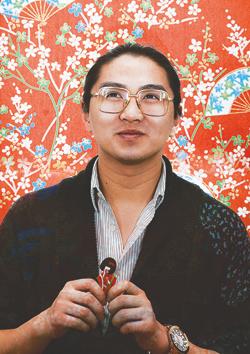Johnson Ngo wants to get personal with you. That is, if you’re willing to get personal with him. Ngo’s upcoming piece, Make Your Own China Doll, is one of 11 in the Rhubarb Festival that will employ a one-to-one performance format, bringing together just one artist and one audience participant for a brief interaction. Attendees thus enter into a substantially more active, and definitely cozier, relationship with the artist behind each piece.
“One-to-one provides a more intimate experience between two people,” says Ngo. “You kind of negotiate the space together, and the other person becomes the performer, too.”
That partnership allows both artist and performer to open up just that much more. In Make Your Own China Doll, Ngo teaches each audience partner to create a “china doll” while discussing a somewhat revealing personal narrative. While the content of that story will remain secret to all but those audience members who choose to take part, its combination with the crafting of an iconic (and stereotypical) Asian figure creates a new critical approach to the complex issues that run through the 24-year-old Ngo’s catalogue of work: how to negotiate the experience of being, as even he puts it, “gaysian.”
“My experiences with it have shaped me as a person and as an artist, and it will always come out in some way, or be read in a certain way,” Ngo says of this intersectional identity. “Because I’m a gay man, regardless of what my goals are at the moment, there’s always going to be some aspect of love or relationships that comes [into my work].”
And sure enough, his pieces have historically been very explicit in their dialogue with race and desire. As part of an interactive art sleepover in 2011 called Eat, Sleep and Breathe (and Shit), Ngo made and ate Vietnamese fresh rolls of varying length and girth with his audience, commenting on the assumption and fetishization of Asian penis size. The result? “They devoured all of them!” Ngo laughs. “I was talking about micro penises and long and skinny ones, but they were all appetizing.”
In several other pieces, both photographed and performed, Ngo has made casts of his face and body out of traditional Vietnamese rice paper, often obscuring his visibly Asian features.
“In one way I’m masking it, but by masking it I’m highlighting it,” he explains. Reflecting on an image in which his body is shown draped in a rice paper toga, including most of his head but for a lock of dark hair, Ngo explains, “I’m referencing classical male nudes and Greek and Roman figures, which inherently references the white male. But I’m not white, and one of the key contrasts I wanted to make was my hair. It is one of the only markers of my Asian-ness that comes out.”
Ngo interrupts and rejects those who would fetishize him and playfully questions those instincts while allowing for some level of inevitability. In Make Your Own China Doll, he gets to collaborate directly with his audience in tackling that duality.
“I used the one-on-one performance as a format to bring me out of my shell, because I usually would do more durational endurance performances where everyone looks at me, and the engagement involves a separation,” he explains. “But this way it becomes this didactic experience, where I discuss a personal narrative but also exchange this skill set to someone else. And we create something together, and there’s something to take away.”
If the closeness of one-to-one performance creates an opportunity for Johnson to be a bit more candid with himself, though, for other performers in the Rhubarb Festival, it means they can bring a friend along in an attempt to recreate somebody else’s experience. In Heather Hermant’s historical piece, the audience is given a role in reenacting the true story of the 18th-century immigrant Esther Brandeau, who passed as a man to come to New France. In Aynsley Moorhouse’s sound art piece, participants are guided on a walking tour through headphones in an effort to recreate the experience of a person living with dementia.
“There are certain ideas you can explore in a private setting with that close physical proximity that you can’t do with a large audience,” explains the festival’s artistic director, Laura Nanni, who introduced the One-to-One Series this year. “With the Rhubarb audience, it was sort of a no-brainer because they’re such an adventurous group.”
And while a fair critique of Rhubarb’s weekend-long experiment with this kind of performance might point out that the very limited run of the pieces, which will be experienced by only a select few, might unfairly contain the performances’ effect on potential larger audiences, Nanni expects an artistic osmosis to carry that impact out into the world.
“There’s sort of a domino effect,” she explains. “[People] will still talk about those concepts before and after. My hope is that the conversation goes beyond the actual physical experience. So in that sense, I think there is a larger audience.”
The one-to-one format, which emerged in the 1970s, has recently become popular in Toronto. A workshop about one-to-one with artist Adrian Howells during last year’s Rhubarb Festival, which included Ngo and other local artists, set the groundwork for the project call this year. Even before the festival kicks off, Nanni is ready to call it a success.
“I feel like all the artists are taking the time to consider their responsibility to the participants,” she says, noting the added expectations the audiences must meet. “It’s kind of risky. It demands a lot of attention. You have to be really ready and present.”

 Why you can trust Xtra
Why you can trust Xtra


